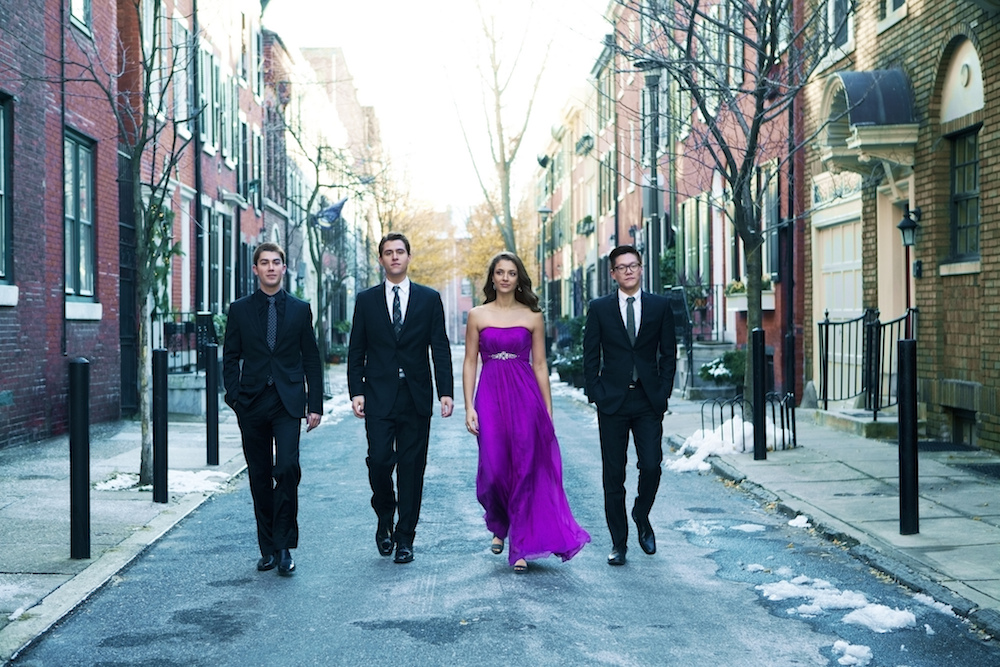
Editor’s note: Robin Elliott is the co-ordinator of the Tuning Your Mind series of pre-concert lectures for the WMCT, and gave the talk before this recital.
A stellar reputation preceded the Dover Quartet of Philadelphia, which gave its Toronto debut recital in Walter Hall for the Women’s Musical Club of Toronto (WMCT) on Thursday afternoon, 13 November.
The young quartet, which was formed at the Curtis Institute in 2008, won the Fischoff Chamber Music Competition in 2010, and swept all of the top prizes at the Banff International String Quartet Competition (BISQC) in 2013. If it continues on its present trajectory, the Dover Quartet will certainly join the elite and rarified ranks of the most celebrated chamber ensembles of its day. Indeed, on the evidence of the recital which it presented for the WMCT, the quartet has already reached the top echelons of chamber music performance.
Haydn’s engaging String Quartet in G major, Op. 76, no. 1 opened the program. The Dover Quartet had the full measure of the many witty gestures in the work, from its surprising opening (Haydn amusingly begins with a typical final cadence, a set of three rousing, fully scored tonic-dominant-tonic chords), to the hilarious concluding gestures of the finale (Haydn pretends to end the work three times before he finally draws the curtain on it).
The third movement presto could have been taken at a slightly brisker tempo; the misleading “Minuetto” indication that Haydn gives the movement is clearly an anachronism, for the work is a scherzo in all but name. But that is a minor quibble; overall this was a satisfying performance, full of interpretive insight and beautifully nuanced expressive gestures. Joel Link, the first violinist and primus inter pares, particularly shone in the extended soloistic passagework in the second and fourth movements, and the trio of the third movement.
Next up was Terra memoria, a 15-minute long single movement for string quartet by the prominent Finnish-born Paris-based composer Kaija Saariaho, whose Love from afar was done by the Canadian Opera Company in February 2012. This quartet movement was commissioned by Carnegie Hall and premiered by the Emerson Quartet in 2007.
The atmospheric work draws upon a range of fairly commonplace extended playing techniques (sul ponticello, sul tasto, col legno, sub ponticello and so on) to evoke what the Dover Quartet’s cellist Camden Shaw in his impromptu remarks before the performance rightly described as “ghostly” sonic images. The movement is nicely structured, emerging from and returning to virtually silent gestures (the players start out by bowing col legno at a pppp dynamic). Though the work is new to the repertoire of the quartet, it was given an utterly convincing performance and was greeted with warm applause.
Beethoven’s String Quartet in E-flat major, Op. 127, the first of Beethoven’s late-period string quartets, was the final work in the program. This is an extremely tricky piece to bring off in live performance, and is full of interpretive difficulties. The opening provides a good example of the challenges; as Michael Steinberg has written, quartets rarely offer a convincing rendition of the rhythms notated by Beethoven in the first six bars, as the harmonic changes undermine the notated rhythmic values.
The Dover Quartet passed this first test effortlessly, and launched into a compelling and thought out interpretation of the work. A particular highlight was the opening of the second movement. This adagio is the emotional core of the work; Beethoven begins the movement by slowly building a dominant seventh chord from the cello up (with the seventh doubled and no third in the chord, interestingly), over which the first violin sings a tune of exquisite, aching beauty.
The playing at the opening of this movement was deeply felt and beautifully realized; it was as gorgeous a string quartet sound as I have ever heard. Overall, this was a performance to treasure; the maturity of the music making completely belied the youthfulness of the players. The appreciative audience responded with a warm and well-deserved standing ovation. The Women’s Musical Club of Toronto has an amazing track record of presenting debut recitals by musicians who have gone on to extremely prominent careers; the Dover Quartet recital is the latest in this string of artistic triumphs.
The CD of the Dover Quartet’s winning performances from the BISQC was selling briskly at the intermission; copies can also be purchased online directly from the Banff Centre website.
Robin Elliott
- SCRUTINY | Beethoven’s ‘Ghost Trio’ Highlights Intriguing Mixed Program By Montreal’s Trio Fibonacci In Toronto Return - October 4, 2019
- SCRUTINY | Poulenc Trio Shows Us Why The World Needs More Oboe, Bassoon, And Piano - October 5, 2018
- SCRUTINY | Peter Oundjian Gives A Sterling “Thank You” To Toronto - June 22, 2018



